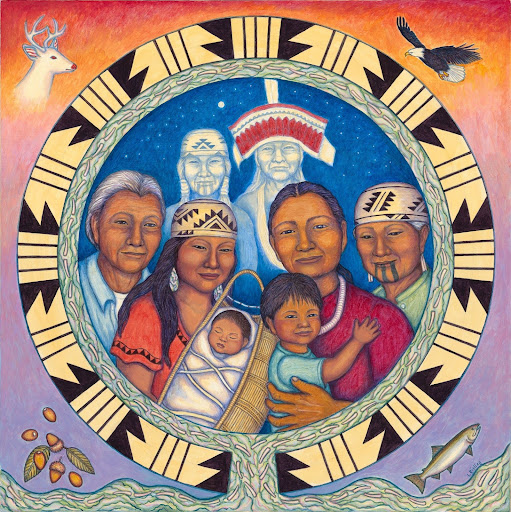Overview
We are Still Here: Lyn Risling, Karuk, Hupa, and Yurok Artist

Authors and Collaborators:
Maggie Peters, Yurok/Karuk Educator, Traditional Basket Weaver, Cultural Preservationist, Native American Studies Model Curriculum Learning Specialist at Humboldt County Office of Education
Lyn Risling, Karuk/Yurok/Hupa Artist, Author, Illustrator, Ceremonial Leader
Julian Lang, Karuk Linguist, Artist
- Video support provided by Joanna Galicha, Graphics & Communications Specialist at Humboldt County Office of Education
We Are Still Here, Fix the World People Unit (Lesson 2 of 6)
- Lesson 1: Notice Wonder Feel
- Lesson 2: Lyn Risling, Karuk, Hupa, and Yurok Artist
- Lesson 3: History and Survival
- Lesson 4: Resilience and Healing
- Lesson 5: Ararachúupha Nuu Payêem Nuchúuphitih (We Are Talking Our Indian Language Now)
- Lesson 6: Expression of Self - Art Inspired by Lyn Risling
Grade: 7
Suggested Amount of Time: 50-55 minutes (designed for multi-period schedule typical of middle schools)
Curriculum Themes
- Cultural Strengths
- Relationship to Place
- Cross Curricular Integration
Learning Goals
- Understand the significance of cultural identity in Indigenous communities.
- Develop empathy and respect for Indigenous cultures and perspectives.
- Explore the role of art in preserving cultural traditions and histories.
- Connect the idea of artists as leaders and activists in their communities.
Lesson Overview
This is the second lesson of the “We Are Still Here, Fix the World People” Art and Karuk Language Integrated Unit. In this lesson, students will have a deeper understanding of the life, cultural influences, and artistic contributions of Lyn Risling, a prominent Native American artist from the Karuk, Yurok, and Hupa peoples in Northwestern California. Students will explore how Risling’s art reflects the traditions, cultural identities, and resilience of Indigenous peoples of northwestern California, and how it connects the past, present, and future of her community.
Lyn Risling is a contemporary artist whose work draws deeply from her Indigenous heritage. Students will watch a short film about Lyn’s journey to becoming an artist and read a short biography. The film will introduce the cultural themes present in Lyn’s work, emphasizing how it celebrates the strong connection to the land, traditions, and the Indigenous experience in the face of colonization. Her artwork portrays themes of resilience, survival, and cultural continuity despite challenges, particularly after the colonization in the 1860s.
Students will continue to apply the same vocabulary words from the first lesson and demonstrate new knowledge in partner activities in reflection of the video and biography.
Teacher Background
To best prepare for delivery of this lesson about Lyn Risling as an artist and ceremonial leader, it’s important to understand the cultural and historical context surrounding her work. Familiarize yourself with the three primary Indigenous tribes in northwestern California—Karuk, Yurok, and Hupa (or Hoopa for the political spelling)—and their unique languages, traditions, and histories, particularly the impact of colonization on these communities. Understanding the challenges these tribes have faced, especially after the 1860s, will help provide important context for Lyn Risling’s artwork, which reflects her peoples' resilience. Please pre-watch the first 13:30 minutes of History and Hope, created to support social workers in Northern California. This video is included in the third lesson of this unit. Video link: https://youtu.be/pG_t0UpHXvc?feature=shared
Lyn’s work is deeply connected to her heritage, especially through her father’s side of the family, which has a long history of involvement in traditional arts and ceremonies. Her participation in the renewal of important cultural practices, such as the Karuk girls' puberty ceremony, is a central part of her life and work. As you prepare to teach, be aware of the significance of art in preserving Indigenous cultures, especially in the face of colonization, and how Lyn’s art serves to tell these stories of survival and renewal. It’s crucial to approach the lesson with cultural sensitivity, ensuring respectful and accurate representation of Indigenous histories and avoiding stereotypes. The lesson provides videos and visual examples of Lyn's artwork to engage students. This lesson should also connect to broader discussions about identity, social justice, and the role of art in activism, encouraging students to reflect on the power of art to influence communities and cultures.

